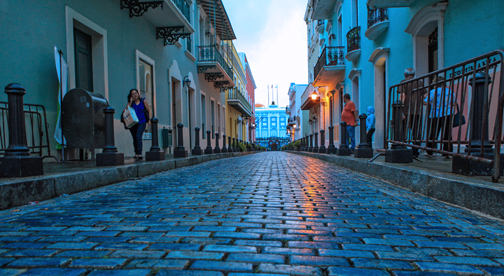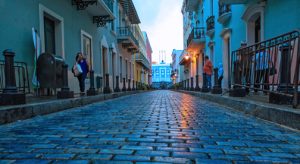SPECIAL REPORT: The toll of the media’s neglect of P.R.


Old San Juan was crippled without electricity for several weeks after Hurricane María hit.
By Polina Meshkova
Special for the Center for Investigative Journalism
Jacqueline Capó walks through Calle del Cristo, paved with blue cobblestones like the other main streets of Old San Juan, Puerto Rico — a city that looks like it came off a Paul Signac painting. The ocean breeze sweeps through narrow passages between colonial pastel buildings with chipped paint, tall wooden shutters and rustic balconies, and ruffles Capó’s emerald blouse. She stops in front of the Cathedral of San Juan Bautista, as the buzzing of power generators starts filling the midday air.
“We’ve already gotten used to that; this is our new reality,” said Capó, a 55-year-old singer and a daughter of the Frank Sinatra of Puerto Rico, the late Bobby Capó, and Irma Nydia Vázquez.
Seven months after Hurricane María, the island still has not recovered. There are power outages. The most recent put the entire island in a blackout.
“We are back to September 20,” Capó said, referring to the day the storm struck.
During the hurricane, most restaurants and stores in San Juan were closed with no set time to reopen. Some never did. The streets of Old San Juan seem empty.
Traffic lights look like hollow eye-sockets, creating chaos on the roads instead of guiding drivers. A few Airbnbs in Old San Juan advertise water and electricity — necessities tourists expect upon arrival anywhere — almost as something extraordinary.
Capó is right: There is a new reality now.
To most Puerto Ricans, including Capó, the support that has come to the island feels like a band-aid stretched over a massive bleeding wound. According to her, rebuilding has been sloppily done if done at all.
“To give you an idea if a job was well done or not, a tree has caused a power outage for over half a million people,” Capó said of another recent blackout.
The poorly repaired power lines are only the tip of the iceberg when it comes to the neglect displayed towards of Puerto Rico. For years, the island has been overlooked and in financial turmoil. Days before the hurricane struck, Suzanne Ramírez de Arellano, a journalist, writer and a former news director for Univision Puerto Rico, alerted key people on major networks — ABC News, NBC, Univision and Telemundo — about the imminent danger of a hurricane of that magnitude.
She expected to receive the same response as to forecasts of hurricanes Irma and Harvey, but that wasn’t the case.
“María came to show what had been happening for decades, which is we are a colonial whim of the United States,” she said. “The Americans have no idea who we are. Forget Washington not knowing, the media has no clue.”
According to Ramírez de Arellano, you don’t need a science degree to look at charts and see how damaging the hurricane would be to the island. Yet, in contrast to the time it took for reporters to be camping out in Florida and Texas awaiting Irma and Harvey, no one turned their eyes towards Puerto Rico with the same threat hanging over the island, even though it is a U.S. territory.
Carlos Vargas-Ramos, a Research Associate at the Center for Puerto Rican Studies at the City University of New York’s Hunter College, said it was evident the hurricane would affect all 78 municipalities of Puerto Rico and 3.3 million people, but the news outlets didn’t give it their full attention during or after and “certainly not before the hurricane.”
“Some of them were there as the hurricane was passing through or immediately thereafter. But was the bulk of the news media present in Puerto Rico in the immediate aftermath of the hurricane? No,” Vargas-Ramos said.
Deep-rooted indifference
While the term “hurricane fatigue” in connection to an extensive coverage of Irma and Harvey is circulating the internet, Ramírez de Arellano said this indifference is rooted much deeper.
“They only care about Puerto Rico, about Latin America, about Central America, when we bleed so profusely that it starts splattering on the walls of Washington,” said Ramírez de Arellano.
But even as Puerto Ricans were “profusely bleeding,” in fact, dying by the hundreds, major networks failed to mention María, in contrast with Harvey and Irma receiving detailed daily coverage.
According to data collected by GitHub.com that contains the percent of sentences per day in online news (digital media websites, such as Mashable, Buzzfeed, and Huffington Post, and web-versions of news outlets, such as CNN, Fox News, and LA Times), there were much fewer mentions of Puerto Rico than of Texas and Florida.
That number, however, spiked to the highest points on two dates: Sept. 26, 2017, when President Trump tweeted about providing more help and visiting the island, Oct. 3, 2017, when Trump landed in Puerto Rico, bringing no specific relief to the hurricane survivors.
“The President came and started throwing paper towels,” Capó remebered. “It was horrible. It was so humiliating. It confirmed what a lot of us think. Your average U.S. citizen doesn’t want Puerto Rico to be a state. They don’t want us.”
The number of mentions in online news went downhill from there.
The data that counted the number of sentences per day on TV News confirms the same indifference towards Puerto Rico in comparison to Texas and Florida.
The statistics are in tune with Washington Post’s analysis that a humanitarian crisis in Puerto Rico wasn’t important enough to the media and the public until it became a what-has-he-done-now Trump story.
While most U.S. media looked the other way, a set of two battery-powered lamps and two flashlights were Capó’s life for three months with no electricity in Puerto Rico. And she was privileged, around 22,562 families still have no power at home.
Lack of recognition had drastic consequences
Capó’s younger daughter, Camila Muñoz, who left for New Jersey after the hurricane and came back in December, felt the drastic consequences or the path to recovery in Puerto Rico were barely recognized on American television, with less than two minutes of broadcast coverage a day, after which then the anchors would move on. That made her turn to social media, where she usually gets the news, and Puerto Rican news pages.
“I would always look more at the local ones (outlets) because they are the ones who know what’s going on, they’re here, and they see everything,” Muñoz said.
Ramírez de Arellano, frustrated by the lack of coverage and overall attention, wrote an opinion piece for The Guardian. She said that the night of the hurricane, the following night and up till this moment people have been turning to social media to get immediate updates on the situation from her friends’ Facebook and Twitter accounts and local media on social networks.
“Hispanics are very savvy consumers of news. You just look everywhere. But in times of crises, it is the human contact you look for first. We needed to know if our families were alive and well,” Ramírez de Arellano said.
Capó who lived through the hurricane and its aftermath admits she has PTSD. Events like power outages put her through another wave of terror. Other Puerto Ricans are also experiencing post-traumatic stress.
Royce Lee, an associate professor of psychiatry at The University of Chicago, said the range of traumas and stressors that can cause people to develop post-traumatic stress disorder (PTSD) has become more inclusive over the years. Based on research, experiencing, witnessing or even learning about serious threats to the self or those close to you is enough to cause it, according to Lee.
“If you think about natural disasters, there are both threats to the self and there are also threats to the people close to you, like family or friends, and we think those kinds of stressors are severe enough that they can cause PTSD in some people,” Lee said.
Capó still tears up when she recalled the first few days after the hurricane: the flooded streets, the tree trunks on the roads, the entire island looking grey and beige instead of vibrant green.
“It looked like an atomic bomb had landed on our island,” she said.
Yet, as some families and individuals have fled and are still fleeing the island, unable to rebuild their lives or find jobs, Capó doesn’t want to leave. She is as attached to the island as her father, whose song Soñando con Puerto Rico (Dreaming of Puerto Rico) describes everything there is to be missed about the island: the breeze, the waves, the blue sky, and “the aroma of coffee.”
Hurricane María cracked Bobby Capó’s tombstone in pieces.
This story is part of a special project in collaboration with students of the Arthur L. Carter Journalism Institute of the New York University (NYU).













